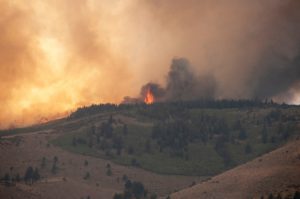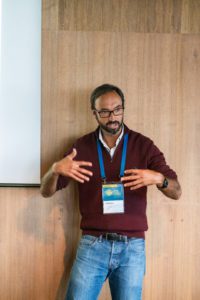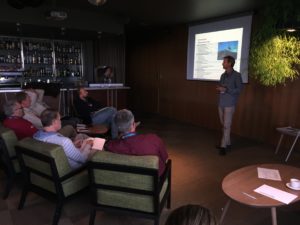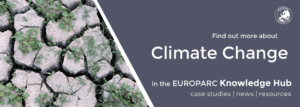Climate change adaptation for Protected Area managers – discussing solutions
Source: Presentation of Cascais’ Action Plan for Climate Change Adaptation
During the Conference 2019 in Latvia, EUROPARC held a number of workshops to discuss diverse topics relevant for Protected Areas management. In case you have not attended, or want to read about their outcomes, a series of online articles summarises their content.
Article by Olivier de Sadeleer, Project Manager LIFE NaturAdapt, EUROPARC.
How do we adapt Protected Area management to a changing climate?
Using 2 case studies from Cascais Ambiente in Portugal and from Teide National Park in Spain, a group of 25 conservation professionals from across Europe discussed and identified key issues and ideas to solve them.
Towards a diagnosis

Climate change effects increase the risk of wildfires globally. Photo by Michael Chacon/Unsplash.
KEY ISSUE 1: “FIXISM”
The discussion highlighted that the uncertainty and the changes expected with a changing climate, will “force” Protected Area managers to adapt and change their practice to work in fast-changing circumstances. Flexibility was identified as an issue since the designation framework is usually slow and purposefully rigid. This is further reinforced by he conservation paradigm, which seems to rest on the idea of permanence. The mental image of what Nature we should protect, how it should look like, and what species should be where, appear to be set in stone. On the same lines, many conservation strategies in Europe are aiming at keeping our fragile natural and cultural heritage as it is.
KEY ISSUE 2: LACK OF DECISION SUPPORT SYSTEMS
The group identified a number of shortcomings when it comes to making decisions on meaningful and effective climate change adaptation plans and measures in Protected Areas:
- lack of expertise about climate sciences and cooperation between biologists and climate experts to understand the coming changes and define priorities;
- lack of knowledge and data on the impact of climate changes on species;
- lack of knowledge/examples/data about potential solutions;
- lack of resources and political support to focus on building and implementing a climate change adaptation program on the long term.
KEY ISSUE 3: COMPLEXITY VS SIMPLICITY, A COMMUNICATION GAP
A short inspiring movie by Greta Thunberg and George Monbiot was played to introduce the workshop. It connected the ideas of climate change, biodiversity extinction and nature-based solutions. Reactions by managers allowed us to highlight the third key issue. The communication gap that exists between:
- the need for simplicity of the message to engage communities and political decision makers;
- the complexity of the issues we face and of the solutions one must implement in the field. We work in very complex socio-eco-systems where everything is interconnected. Many stakeholders are involved potentially competing on land use.
Besides those key issues, participants mentioned the existing land ownership structure and land use planning as problematic for the implementation of large-scale efficient and nature-friendly climate adaptation strategies. A significant number of conservation professionals felt that they have little influence (unfortunately) on such topics.
Building up solutions
In a second step, with a different group of 35 people this time, we looked at drafting the foundation of solutions to one of the above issues in a “world cafe” format. The group chose to look at key issue “FIXISM“.
THE DISCUSSED SOLUTION

João Dinis presents the benefits that the development of a climate change adaptation plan brought to Cascais ambiente.
The discussion looked into how to support the evolution of the mindset of conservation professionals, experts and policy makers towards a dynamic framework. That paradigm shift should enable nature conservation professionals and local communities to address climate change and biodiversity loss challenges as one.
The transformation of nature conservation education and legal framework and policies were identified as keystones and major steps forward. Concretely, it should evolve to:
– put conservation of natural processes first, before heritage;
– invest in the conditions to have a “functional biodiversity”;
– work on large-scale conservation designations (catchment areas, landscape, …);
– reintroduce the idea of large wilderness sanctuaries where natural processes can operate freely.
Keeping climate change adaptation and mitigation in mind, it is essential to redefin the overarching common goals, on a large scale, for nature conservation and recovery.
WHO SHOULD BE HELD ACCOUNTABLE?
The obvious response of many participants included the policy makers (1), the people who actually write the policies that frame nature conservation practice and funding in Europe. In other words the DGs in the European Commission, the Members of the European Parliament, the National and Regional Environment Agencies. Those actors, together with the different influencers and lobbies do define the framework in which protected area managers then work. Most of what influences policies seems to come from political parties, their scientific advisers, expert groups and NGOs.
As far as education is concerned, participants unanimously agreed that the change should come from professors and researchers (2) in Universities first. There is a limitation to this statement as nature conservation practice as such does not seem to be taught directly in universities. It looks like most Protected Area managers hold degrees in ecology, biology, … and then train as nature conservationists on the job or through continuous education provided by the conservation community (3) through federations, NGOs, environmental agencies…

Participants at the Workshop 5.3 on Climate Change adaptation
Last but not least, the responsibility of change obviously lies with those doing the job everyday, in the field. The Protected Area management teams (4) interpret research findings and legal frameworks to implement conservation action plans in and around Protected Areas. This is good news – it is our own community, the ones with whom we can collaborate.
The conclusion was that this is where we should start.
How do we make it happen concretely?

Conference workshop on Climate Change adaptation. Latvia, 2019
The main conclusion is that one way to tackle this challenge is to organise a large-scale debate within the conservation community to co-design a new common vision for nature conservation (or recovery?) in Europe with climate change and biodiversity loss in mind. On top of Protected Area managers, this debate should involve policy makers and universities from the start.
Concretely, there is a need to create a “space” for the debate to happen constructively. It could be a consultation that leverages expert groups, surveys, workshops, conferences, that delivers a common, agreed and ambitious vision for nature conservation in Europe, as well as examples of what a healthy Nature looks like and how it benefits human communities beyond ecosystem services.
A participant mentioned that the EUROPARC Federation with its new strategy could be well suited to host a large-scale debate on European nature conservation in a changing climate.
Conclusion
Climate change is a major threat for Protected Areas. It will bring change and is likely to increase pressure on ecosystems functions. At the same time, it holds the opportunity to innovate and to collaborate on a large scale to put nature back on the agenda.
About the workshop
Workshop 5.3. run at the Europarc 2019 Annual Conference, in Jurmala, Latvia.
Moderator: Olivier de Sadeleer – Project Manager, LIFE NaturAdapt, EUROPARC Federation with the ever-smiling support of Anne-Cerise Tissot, Project Coordinator, LIFE NaturAdapt, RNF
Presenters:
- Case Study Cascais Ambiente: João Dinis – Head of Office for accelerating urban transition in Cascais Ambiente
- Case Study Teide National Park, Jose Antonio Atauri Mezquida – Coordinador de proyectos, EUROPARC España

LIFE NaturAdapt is a 5-year project developed with the support of LIFE, Agence Française de la Biodiversité and Ministère de la Transition Écologique et Solidaire, France.
